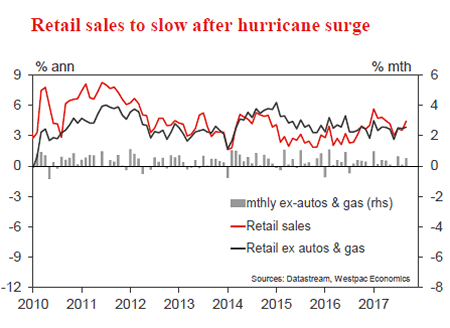Week beginning 13 November 2017
- Statement on Monetary policy: RBA lowers inflation forecasts.
- RBA: Deputy Governor Debelle and Asst. Governor Ellis speak.
- Australia: Westpac-MI consumer sentiment, wage price index, labour force.
- NZ: house sales and prices.
- China: property prices.
- US: CPI, retail sales.
- Central banks: ECB’s Draghi, Fed’s Yellen, BoE’s Carney and BoJ’s Kuroda in discussion.
- Key economic & financial forecasts.
Information contained in this report was current as at 10 November 2017.
Statement on Monetary Policy: RBA Lowers Inflation Forecasts
The Reserve Bank has just released its November Statement on Monetary policy.
We have been surprised by some of the forecast changes in the statement. These forecasts are critically important because they summarise the Bank’s view on the growth and inflation outlook.
In the August Statement on Monetary Policy, GDP growth was forecast at 2-3% in 2017, 2 ¾-3 ¾% in 2018, and 3-4% in 2019. These forecasts are largely unchanged for the November revisions. Growth is still forecast at 2 ½ per cent in 2017, 3 ¼% in 2018, and 3 ¼% in 2019 (down slightly on the August forecast of 3-4%). The forecast unemployment rate from the August statement was 5-6% for 2017, 2018 and 2019. In this statement, the forecast is 5 ½% in 2017; 5 ½% in 2018, 5 ¼% in 2019. This slight reduction in the unemployment forecast for 2019 is more consistent with the above trend growth forecast for 2018 and 2019 than we saw in August.
The big change comes with the policy sensitive inflation outlook. Underlying inflation is now forecast at 1 ¾% for 2017; 1 ¾% for 2018, and 2% for 2019. These changes should not be entirely attributed to the revised weights in the CPI as released by the Australian Bureau of Statistics on November 6th.
These changes are much more significant than that from a policy perspective.
The Bank is now telling us that over the whole course of 2018, inflation will remain below the bottom of its 2-3% target zone, and in 2019, it will only reach 2%, the bottom of the target range. This is a significant departure from the forecasts in August. The August forecasts had underlying inflation at 1 ½-2 ½% in 2017; 1 ½-2 ½% in 2018 and 2-3% in 2019. That is, the outlook for 2019 was underlying inflation to be back in the middle of the target band.
It would be inappropriate to merely attribute these changes to a mechanistic adjustment. Bear in mind that the Bank has discussed the prospect of these weight changes in previous speeches and statements and had noted that previous adjustments took around 0.2% off the measured level of yearly underlying inflation. It is reasonable to assume that with the knowledge that the re-basing was imminent, such an adjustment would have been taken into account, informally, in previous forecasts.
It is our view that the decision to lower the forecasts to below the bottom of the band in 2018 and at the bottom of the band in 2019 has significant policy implications. We are now assessing a central bank which is expecting that it will undershoot its core inflation target for another year, and that even one year out, inflation will still be at the bottom of the target zone.
It has always been our view that with the confident growth forecasts of ½ a per cent above potential growth in 2018 and ¾ above potential in 2019, and inflation moving back to the middle of the target in 2019, the Bank expected to be raising rates in 2018.
These new forecasts cast considerable doubt on that view.
Recall, that in May 2016, when the Bank was forced to lower its underlying inflation forecast to 1 ½ per cent, it immediately cut rates by 25bps. It is uncomfortable for a central bank to be consistently undershooting its target, and it would be surprising if it felt the need to tighten policy at a time when inflation is below its target. That is especially true when the expectation for the next year, when policy can be anticipated to have its effect, is that inflation will only be at the bottom of the target zone.
We are not changing our view that rates will remain on hold in 2018 and 2019, but we have always been uncomfortable that the central bank’s forecasts were implying that it was expecting that it would be raising rates in 2018. These forecasts no longer portray a central bank that expects to raise rates.
The growth outlook
The bank provides a useful analysis of the risks around the growth outlook. Recall that it has retained its 3 ¼% growth forecast in 2018, and has slightly lowered its 2019 forecast. Some key observations around their views are:
1. They have become more confident around the non-mining business investment outlook, particularly referring to some recent upward revisions which point to stronger momentum in that regard. However, they continue to link faster growth in investment to businesses’ assessment of rising household consumption.
2. The core forecast expects that consumption will "pick up a little", along with "a gradual increase in wage growth", however they are decidedly uncertain about both prospects. While they note that some industries are having difficulty attracting labour, they also point out that wage growth in newly negotiated enterprise agreements has declined. The Bank also has revised down its forecast for the recovery in average earnings which have even undershot the admittedly weak wage price index, probably reflecting a rebalancing in the jobs mix to low paid jobs.
3. The expectation for rising wages growth is clearly dependent on ongoing strength in jobs growth and a fall in the unemployment rate reducing spare capacity in the labour market although the ongoing rise in the participation rate represents a risk. On the other hand, there is this uncertainty about structural factors, including technology and globalisation, which may be restraining wages growth given benign wages growth in many countries which have even tighter labour markets.
4. The Bank also recognises other factors that may constrain incomes and spending particularly high household indebtedness and changes in wealth. With house prices now losing momentum particularly in Sydney, wealth perceptions may constrain spending.
5. The Bank has also lowered its outlook for dwelling investment now expecting it to peak earlier than previously anticipated. However, it still assesses that dwelling investment will have a neutral effect over the forecast period.
Our lower growth forecasts for next year at 2.5% are predicated on weaker household consumption than the Bank implies; a sharper downturn in residential investment and a more modest uplift in non-mining business investment. All these issues are interconnected with weaker signals from the household sector likely to weigh on business confidence and employment decisions while a sharper downturn in housing construction will generate spare capacity in the building sectors and ease jobs growth.
Conclusion
This is a significant set of forecast revisions and we believe signals a changed policy outlook from the Bank itself. While the Governor will continue to indicate that the next move in rates will be up, we think that the rhetoric around a long period of steady rates will gain further emphasis.
Forecasting another year of inflation undershooting the target zone might, in other circumstances signal a central bank which is contemplating further rate cuts. However, it still believes that growth will lift to above trend, and the experience of 2016, when two rate cuts triggered another surge in house prices will temper any inclination to cut again.
The Week that Was
This week began with our understanding of Australia’s inflation story being ‘revised’ and ended with the RBA making a significant adjustment to their forecasts. In between, we saw progress on tax reform in the US; although on this front, developments to date are best regarded as a work in progress.
Firstly on the CPI, we have released a number of pieces this week that have detailed both the quantitative and qualitative effect of the ABS’ reweighting of the CPI basket. See chart of the week below for further detail.
The other big event in Australia this week was the RBA’s November meeting and the release of the November Statement on Monetary Policy. The monthly meeting came and went with little fanfare, but the November Statement received considerable attention.
The change that particularly caught our eye was the significant downward revision to their CPI forecasts. Inflation is now not expected to get back to the bottom of the target band (2%) until 2019.
As our Chief Economist Bill Evans explains, this cannot solely be put down to the CPI reweighting (highlighted above) and comes despite expectations of above-trend growth from 2018 on.
Bill’s conclusion on the Statement is in the essay above.
Before moving on to the international economy, it would be remiss to not highlight our latest monthly, Market Outlook. In this edition, in addition to discussions on the outlook for the Australian dollar and interest rates, the thematic articles investigate the outlook for business investment and central bank exploration into the world of digital currencies and distributed ledger technologies. Other important themes are the persistence of highly-accommodative monetary policy in Europe, with consequences for the Euro, and the outlook for China following the five-yearly National Congress.
This Market Outlook also contains updated forecasts from our New Zealand team following the recent election and this week’s RBNZ policy meeting. On the NZ economy, government spending will increase in time; regarding monetary policy, the new government is likely to change the framework that governs the RBNZ’s decision making. In the meantime, our NZ team continues to believe that the RBNZ’s optimistic expectations for the economy will be disappointed and that policy will remain on hold until late 2019.
Outside of Australia and New Zealand, the most significant development this week has been continuing progress on US tax reform in both the House and Senate. The issue is, that rather than work together, the two halves of Congress have each formed their own plan which, while based on the same ‘principles’, are actually quite different.
Negotiations will continue in coming weeks and inevitably a compromise package of reforms will be brought before Congress for a vote. In Northern Exposure this week, we abstract from the political uncertainty and focus instead on assessing, should reform occur, will it mean much for the real economy? Our conclusion is that, for households, any benefit is likely to marginal and temporary; for corporates, a near-term win from a lower corporate tax rate will give way to considerable uncertainty in the longer-term.
Chart of the week: ABS CPI 17th series
The ABS maintains a program of periodic reviews of the Consumer Price Index (CPI) to ensure it continues to meet community needs. On Monday, the ABS released the details of the 17th series, which they state is a minor review of the CPI.
For the 17 series the ABS has updated the upper level (expenditure class) weights in line with the latest Household Expenditure Survey (HES). This is done as the CPI is a fixed weight index and the weights have to be revised from time to time to bring them in line with the latest spending patterns associated with changing technology and individual preferences as well as correcting a substitution bias that emerges over time as spending tends to rise (fall) for items where relative prices have declined (risen).
Incorporating the changed weights, we struggle to see a peak in headline inflation any higher than 2.0%yr for the foreseeable future. Key to this outlook is ongoing competition amongst retailers as well as the impact greater housing supply is having on rents.
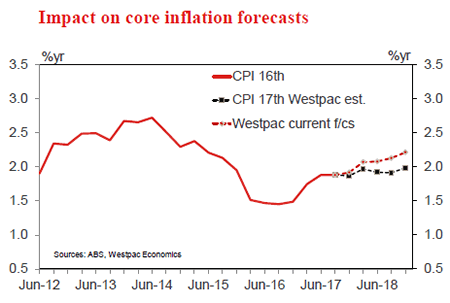
New Zealand: Week Ahead & Data Wrap
This week’s Monetary Policy Statement was very much in line with expectations. The Reserve Bank left the OCR unchanged at 1.75% and issued the same forward guidance it has used all year. Essentially, the OCR is on hold, and the RBNZ expects that it will remain on hold until 2019, although there are large uncertainties on both sides.
While the overall tone of the MPS was both neutral and much the same as previous missives, there was a lot going on beneath the surface. The RBNZ acknowledged that the housing market and construction activity were weaker than previously anticipated, and downgraded its forecasts in both areas. This downgrade was overdue – we had complained that the RBNZ was too optimistic on construction and house prices in its August MPS. But offsetting these downside developments, the RBNZ acknowledged that the lower exchange rate will support inflation, and that the Government’s fiscal plans would stimulate the economy.
The standout for us was the RBNZ’s extraordinary optimism about future GDP growth. The RBNZ estimates that the economy grew 0.7% in the September quarter this year, whereas our estimate is 0.4%. The RBNZ goes on to forecast that GDP growth will be 0.9% in December 2017, rising to 1.2% in March 2018. That would make March the strongest quarter of GDP growth in four years. These are heroic forecasts, to say the least. In recent times we have seen business confidence dropping away, the housing market slow and construction activity stagnate. With the uncertainty associated with a change of Government lying ahead of us and population growth slowing sharply, we find it highly unlikely that the economy will reach these heights. Our own forecast for GDP growth in the March 2018 quarter is 0.5%.
The RBNZ is also very optimistic on GDP growth over a longer timeframe, based on the idea that the new Government’s policies will tend to boost the economy. In turn, this will apply upward pressure to inflation, necessitating a higher OCR than otherwise. The RBNZ looked at four areas of proposed Government policy: extra spending on education and health, the Kiwibuild residential building programme, hikes to the minimum wage, and plans to reduce incoming migration to New Zealand. On balance it judged these to be a positive stimulus to inflation, necessitating an OCR perhaps 50 basis points higher than otherwise.
We broadly agree with the RBNZ on these areas, although we would quibble with their assumptions around Kiwibuild – we think it will mostly displace private sector activity and will therefore have little impact on overall construction activity.
But we suspect that the RBNZ has not allowed enough for the Government’s plans around the property market. The Government is planning to restrict foreign purchases of residential property and to change the tax treatment of property investors. Furthermore, it plans to convene a tax working group that might recommend a capital gains tax or similar. We expect that these actual and prospective tax changes will cause the housing market to weaken noticeably next year.
Furthermore, the RBNZ is assuming that any weakness in the housing market will have little impact on consumer spending. Here we disagree strongly, and recent evidence is on our side. This week’s electronic card transactions data registered yet another very small rise in spending, despite booming population growth. Spending on durables has been particularly weak, falling 2% over the past three months. This looks to us like a classic response to a weak housing market, which could intensify next year if house prices remain soft.
The other area that the RBNZ may be disappointed in is export conditions. We expect New Zealand’s export commodity prices to fall next year, due to an expected slowdown in China’s economy. Indeed, dairy auction prices are already falling – this week’s auction registered a 3.5% decline in the overall dairy price index, with whole milk powder down 5.5%. This is the latest in a string of auction price declines, which has cumulatively been enough for us to downgrade our forecast farmgate milk price for the 2017/18 season to $6.20/kg (previously $6.50). Fonterra’s $6.75/ kg forecast is now looking well out of market. We have also published for the first time our milk price forecast for the 2018/19 season. We expect the payout to increase to $6.50/kg, on the basis of a revival in the Chinese economy from late 2018 and supported by a lower average exchange rate over the season.
Putting all of this together, we expect that the RBNZ will be surprised by slow GDP growth, weak house prices and falling export commodity prices over 2018. If we are correct, the RBNZ will become more dovish.
There could be a couple of other knock-on effects to consider. First of all, the exchange rate would fall even further in these conditions, providing some offset from an inflation point of view. Second, a weak housing market could prompt the RBNZ to loosen macro-prudential policy. The RBNZ Governor this week said that the criteria under which the LVR mortgage lending restrictions may be loosened will be outlined at the Financial Stability Report on 29 November. Any loosening would likely be incremental, but still might have a positive influence on the housing market.
Data Previews
Aus Nov Westpac-MI Consumer Sentiment
Nov 15 Last: 101.4
- The Westpac-Melbourne Institute Consumer Sentiment Index rose 3.6% to 101.4 in Oct, the first time since Nov last year that optimists have outnumbered pessimists and the highest level since Oct 2016. The lift has come from an improving global economy, easing concerns about rising interest rates and over-heated housing markets, and improving labour market conditions. However, confidence is still not particularly strong, with views on family finances a clear weak spot.
- This month’s survey is in the field over the week ended Nov 11. Factors that may influence confidence include: the RBA’s decision to again leave rates on hold; more signs of cooling across Australia’s major housing markets; disappointing retail updates; and renewed political instability. Notably, the ASX is also up over 5% since Oct.
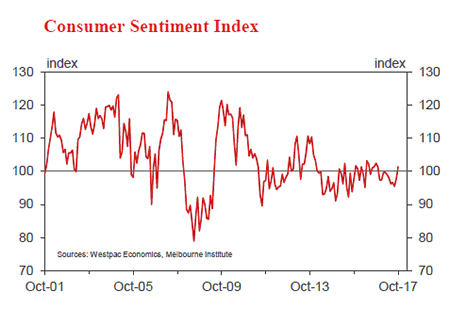
Aus Q3 Wage Price Index
Nov 15, Last: 0.5%, WBC f/c: 0.7%
Mkt f/c: 0.7%, Range: 0.5% to 0.8%
- Wages have lagged the recovery in the Australian labour market. While it is part of a global phenomenon of wage deflation, there are domestic considerations as well. Rising part-time employment and underemployment have a role to play particularly in Victoria which has the fastest population growth and higher rate of employment growth.
- The rise in the national Minimum Wage has an impact in the September quarter Wage Price Index. The RBA has estimated a direct impact of 0.5ppt boost in the quarter due to the increase. Given that the previous Minimum Wage increases contributed 0.3ppt, the net impact of the increase is a 0.2ppt boost to the underlying pace.
- Our 0.7%qtr forecast will lift the annual pace to 2.3%yr, the fastest pace since September 2015.
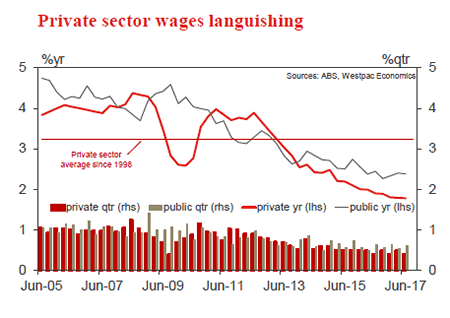
Aus Oct Labour Force – employment ‘000
Nov 16, Last: 19.8k, WBC f/c: 20k
Mkt f/c: 18k, Range: -10k to 30k
- Total employment increased by 19.8k in September, broadly in line with the market median forecast of +15.0k and Westpac’s forecast of +25.0k. Part-time employment grew 13.7k, while full-time rose 6.1k, though importantly hours worked posted a solid 0.7% gain. September’s result was consistent with the positive momentum seen over 2017. After the Australian labour market went through a soft patch in 2016, employment gathered steam as we moved through 2017 rising 371k or 3.1% through the year to September.
- Westpac’s forecast of a 20k rise will be a record breaking 13th consecutive monthly gain in employment. It may be tempting to look for a statistical correction but the strength of the labour market indicators in both consumer and business surveys suggest the underlying momentum remains very robust.

Aus Oct Labour Force – unemployment %
Nov 16, Last: 5.5%k, WBC f/c: 5.5%
Mkt f/c: 5.5%, Range: 5.4% to 5.6%
- The unemployment rate fell to 5.5% with the participation rate holding at 65.2% though August’s number was revised lower from 65.3%. In the month the labour force increased just 7.9k. Note that at two decimal places, participation fell slightly to 65.21% from 65.25%, with male participation falling to 70.7% from 70.8% and female participation falling to 59.8% from 59.9%.
- We are expecting the continuing robust growth in employment to draw more people into the labour force, particularly females. This is behind our forecast for a small rise in participation to 65.3% which will hold the unemployment rate flat at 5.5%.
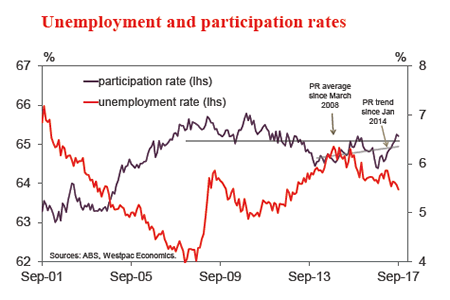
NZ Oct house sales and prices
Nov 15, Sales last: -6.9%, Prices last: 2.1%yr
- The housing market weakened over much of 2017, with prices falling in Auckland and nearby regions. But over August and September there were signs of the housing market perking up in the REINZ data. Prices rose by 1% in September.
- Other sources of data corroborate the idea of the market improving slightly. Available stock on a real estate website has dropped, and another website has reported a rising average asking price.
- While uncertainty around post-election outcomes (a coalition agreement was announced on 19 October) may have kept housing turnover in check, the October REINZ data might show a further lift in house prices.
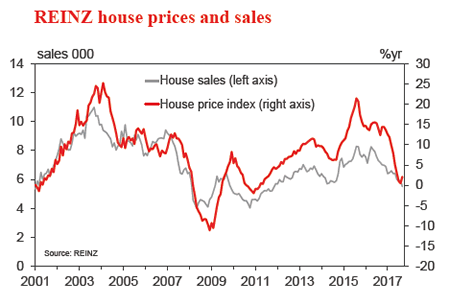
US Oct CPI
Nov 15, last 0.5%, WBC 0.1%
- September’s headline CPI outcome was dominated by Hurricanes Harvey and Irma. Following a 0.4% gain in August (also hurricane affected), prices rose 0.5% in September. That left the annual pace at 2.2%yr.
- Of the monthly gain, 75% of the increase reportedly came from a surge in gasoline prices after refining operations were heavily impacted by the weather.
- Abstracting from this factor, inflation pressures remained benign. The core CPI rose by just 0.1%, leaving the annual rate unchanged at 1.7%yr for a fifth consecutive month.
- The headline and core CPI outcomes are expected to be soft in October, with both likely to print at 0.1%. On both a CPI and PCE basis, there is no cause for concern on inflation.
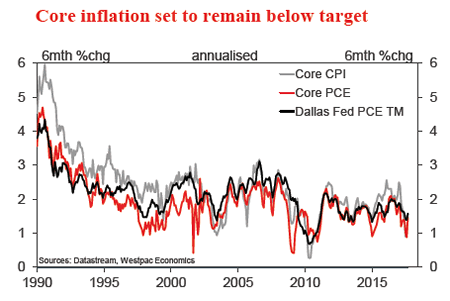
US Oct retail sales
Nov 15, last 1.6%, WBC 0.3%
- Retail sales received a large boost from restocking in the month of September in the aftermath of Hurricanes Harvey and Irma.
- There were two particularly notable weather effects in the month: (1) car sales surged in affected areas as consumers replaced vehicles written off in the storm; and (2) the surge in gasoline prices flattered total nominal sales.
- Both effects will be largely absent in October. Hence our expectation that sales will rise by just 0.3% following September’s 1.6% jump. The market forecast of 0.1% points to some downside risk. Broadly, it has long been hoped that confidence and job gains will drive stronger sales. However, soft wages growth continues to get in the way.
